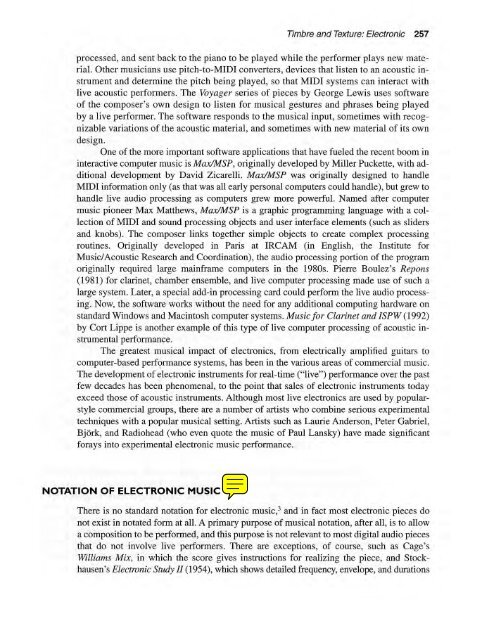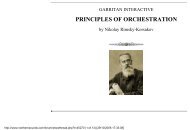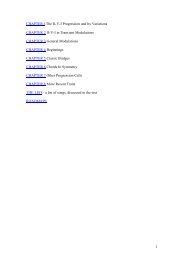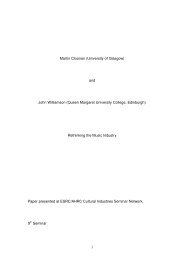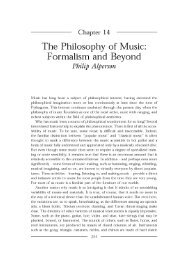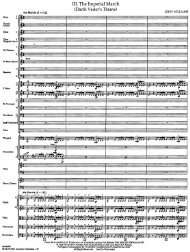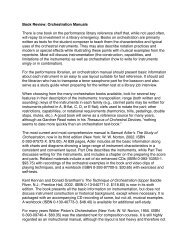TWENTIETH- - Synapse Music
TWENTIETH- - Synapse Music
TWENTIETH- - Synapse Music
You also want an ePaper? Increase the reach of your titles
YUMPU automatically turns print PDFs into web optimized ePapers that Google loves.
Timbre and Texture: Electronic 257<br />
processed, and sent back to the piano to be played while the performer plays new material.<br />
Other musicians use pitch-ta-MIDI converters, devices that li sten to an acoustic instrument<br />
and determine the pitch being played, so that MIDI systems can interact with<br />
live acoustic performers. The Voyager series of pieces by George Lewis uses software<br />
of the composer's own design to listen for musical gestures and phrases being played<br />
by a live performer. The software responds to the musical input, sometimes with recognizable<br />
variations of the acoustic material, and sometimes with new material of its own<br />
design.<br />
One of the more important software applications that have fueled the recent boom in<br />
interactive computer music is MaxiMSP, originally developed by Miller Puckette, with additional<br />
development by David Zicarelli. MaxiMSP was originally designed to handle<br />
MIDI information only (as that was all early personal computers could handle), but grew to<br />
handle live audio processing as computers grew more powerful. Named after computer<br />
music pioneer Max Matthews, MaxiMSP is a graphic programming language with a collection<br />
of MIDI and sound processing objects and user interface elements (such as sliders<br />
and knobs). The composer links together simple objects to create complex processing<br />
routines. Originally developed in Paris at IReAM (in English, the Institute for<br />
<strong>Music</strong>/Acoustic Research and Coordination), the audio processing portion of the program<br />
originally required large mainframe computers in the 1980s. Pierre Boulez's Repons<br />
(1981) for clarinet, chamber ensemble, and live computer processing made use of such a<br />
large system. Later, a special add-in processing card could perform the live audio processing.<br />
Now, the software works without the need for any additional computing hardware on<br />
standard Windows and Macintosh computer systems. <strong>Music</strong> for Clarinet and ISPW (1992)<br />
by Cort Lippe is another example of this type of live computer processing of acoustic instrumental<br />
performance.<br />
The greatest musical impact of electronics, from electrically amphfied guitars to<br />
computer-based perf9rmance systems, has been in the various areas of commercial music.<br />
The development of electronic instruments for real-time ("live") perfonnance over the past<br />
few decades has been phenomenal, to the point that sales of electronic instruments today<br />
exceed those of acoustic instruments. Although most live electronics are used by popularstyle<br />
commercial groups, there are a number of artists who combine serious experimental<br />
techniques with a popular musical setting. Artists such as Laurie Anderson, Peter Gabriel,<br />
Bjork, and Radiohead (who even quote the music of Paul Lansky) have made significant<br />
forays into experimental electronic music performance.<br />
NOTATION OF ELECTRONIC MUSIC<br />
There is no standard notation for electronic music,3 and in fact most electronic pieces do<br />
not exist in notated fonn at all. A primary purpose of musical notation, after all, is to allow<br />
a composition to be performed, and this purpose is not relevant to most digital audio pieces<br />
that do not involve live performers. There are exceptions, of course, such as Cage's<br />
Williams Mix, in which the score gives instructions for realizing the piece, and Stockhausen<br />
's Electronic Study II (1954), which shows detailed frequency, envelope, and durations


